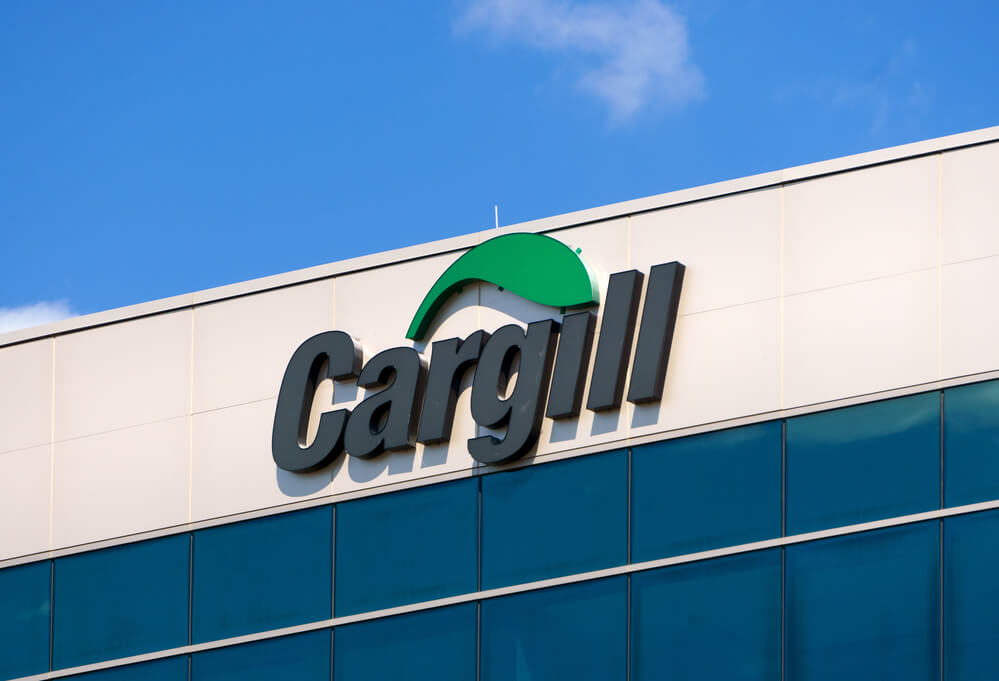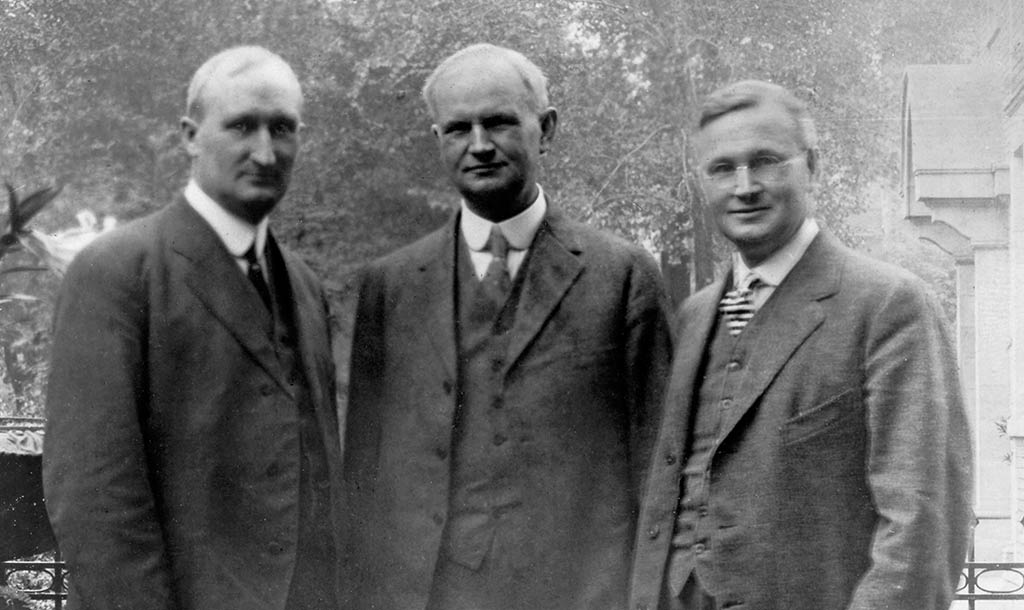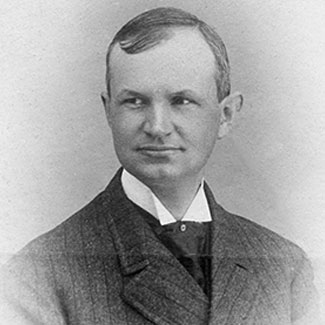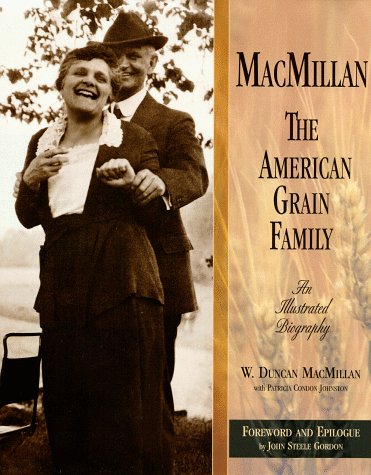Cargill: how the most secretive US billionaires live

Фото: Depositphotos
Cargill - The largest US private company that controls the lion's share of US food exports, supplies animal feed and raw materials for fast food chains. Since 1986, the company has only twice lost to the first line of the ranking of the largest private companies in the United States. Forbes.
The Cargill-Macmillan clan, one of America’s richest families, managed to turn a granary on the outskirts of Iowa into a multi-billion dollar business. The order of 90% of the giant's shares is controlled by about a hundred people bearing the names of Cargill and Macmillan. Of these, 14 billionaires are more than any other clan, both in the US and beyond.
Since 1946, the company's headquarters is located in a chateau in Minnesota. 63 rooms, 17 bathrooms, 13 fireplaces and 40 top managers making plans for enrichment and absorption. The story of this family business is the story of five generations of executives. Cargill appeared more than a century and a half ago, and the rapid expansion of the firm of William Wallace Cargill in the last third of the XIX century was not much different from similar climbs. Like John Rockefeller and Henry Ford, the founder of the food giant had uncommon boldness, creativity, determination, and was - without this in any way - kissed by fate. The difference is that the heirs of Cargill went through the crises of the 20th century, keeping the business in the hands of the family. And most importantly - the company earned good money on key trends of the era.

Road to wealth
1839 year, Long Island. Scottish captain William Dick Cargill marries Edna Davis, the niece of two famous American artists. Soon the young go into the depths of the continent: Edna, as historians believed Cargill did not like the sea and decided that her sons should be brought up as far as possible from the coast. The sons were seven, and William Wallace appeared the third in the Cargill family in 1844.
William Wallace Cargill was born in New York, but he spent his childhood on a farm in Dzhansville. The youth of the future tycoon fell on the years of the Civil War. Unlike the older brothers, William didn’t manage to make war. However, the youthful energy demanded a way out, and in 1865, he left his native Wisconsin to settle down in Iowa to start his own business.

William Wallace Cargill Photos: MacMillan: The American Grain Family
The victory of the North over the South has freed up the masses of labor - there is an active migration of the population and the development of new territories, the prairies are quickly built up with farms and roadside infrastructure. Far-sighted William arranges a grain warehouse in Conover (which has now become a ghost town on the outskirts of Iowa), at the terminal station of the local railway, and customers begin to flock to it. The scheme of work was simple: Cargill either offered farmers a room for storing grain, for which they, finding a buyer, paid him a commission, or bought the grain himself immediately after the harvest. Most small producers then took out loans in the hope of a good harvest and high prices. If the market went against them, they found themselves in a difficult position. Then William appeared, offering some money. Meanwhile, grain demand in major US cities was very high, but the entire crop was located in remote rural areas, often thousands of miles away, and rail or waterways were required for transportation. William understood that logistics was becoming a key area in a rapidly expanding country. For twenty years, the Cargill brothers followed the development of the railway network, building, renting and buying barns, creating retail outlets on new routes. By 1890 year Cargill Owned hundreds of elevators that can accommodate about 4,3 million tons of grain.
In 1875, William returned to Wisconsin. The businessman got married, joined the Masonic Lodge, and became close to other Scottish immigrants, among whom was Duncan John Macmillan, a logger and financier. In 1895, the clan heirs became related: Edna Clara Cargill married John Hugh MacMillan, and William “Willie” Samuel married Mary Macmillan.

John Macmillan Photo: MacMillan: The American Grain Family
In 1909, the founder Cargill He died, leaving a growing but heavily indebted company - a year before his death, he started a project to renovate the transport infrastructure in Montana, which eventually failed. To save the situation, the creditor committee actually divided the business into two parts. Willy was engaged in solving financial problems, and John received a flourishing grain direction. The first did not succeed, but the second showed remarkable abilities and soon, after taking as allies one more son of Cargill - Austin, he achieved the removal of Willy. Since then, control over the company has been concentrated in the hands of the descendants of Macmillan and the youngest branch of the founder. Cargill.
Make money out of trouble
John Macmillan was in his place. For six years, he managed to stabilize the business, to which World War I contributed a lot. The peasants of the Old World were entrenched in the trenches, and the price of bread soared to heaven. Thanks to deliveries to Europe and army orders Cargill paid off old debts already in 1915 year.
After the end of the war, a period of rapid growth of the company begins: it opens an office in New York, acquires port facilities and absorbs one of its competitors - Taylor and Bournique, Co. Maximum teletype usage allows traders Cargill respond faster to market fluctuations. The company is starting to export hybrid seeds. In 1929, the first overseas branch of the company appears in Argentina.
And even the Great Depression, which brought grain prices down, helped Cargill strengthen its position: the company was buying impoverished independent elevators. In 1936, all the assets of the giant are united under the sign Cargill, Incorporated. In the same year, John Macmillan Jr. became president of the company. The third president, according to his contemporaries, while maintaining his father’s generally cautious policies, was distinguished by an explosive reaction and easily went into conflict with federal agencies. However, it was under Macmillan Jr. sales of the company for the first time reached $ 1 billion.
Diseases of growth
In 1940, the order of 60% revenue Cargill brought foreign markets, at the same time the company launched its first dry-cargo ship. However, plans to create their own merchant fleet confused the war. Despite the modest experience in shipbuilding, McMillan wins the tender for the construction of oil and gas tankers for the US Navy. During the war years from the shipyard Cargill 18 ships and 4 tugs.
World War II, in contrast to the First, had on Cargill Negative influence. To recover the lost, the company proceeded to a large-scale diversification. In 1943 year Cargill acquires several soybean processing plants. In 1945, it buys a large company that produces animal feed. Both turned out to be very helpful: 20 years both industries were considered the fastest growing in agriculture. The deadlock example of diversification was for Cargill consumer goods sector. What the company did not sell at the end of 1940's: tires, refrigerators, household utensils ... Formally, all this was meant for farmers. But at the same time came out a salvation for the mass consumer. However, the post-war market quickly stabilized, and shops Cargill began to bring damage. In 1960's Cargill begins to mine and transport salt along the river.
From Brezhnev to Hussein
The end of 1950's was marked for Cargill serious losses. In 1957, Austin Cargill died, three years later John Macmillan Jr. died. Then his younger brother, Cargill Macmillan, suffered a stroke. Suddenly the company was left without a family member worthy of the main post. Five representatives of the next generation agreed that none of them has enough managerial experience. It was then for the first time that it was decided to invite an unrelated employee to the presidency - Erwin Kelm. This period spanned 15 years. However, the shareholders still consisted exclusively of Cargill and Macmillans.
In the 1960 Cargill starts selling bread to the states of the Eastern bloc. First, the process moves with difficulty - in the midst of a cold war, and you have to trade through a subsidiary in Canada. But "detente" begins, and the White House lifts restrictions on grain supplies to the Soviet Union. As a result, about a quarter of all wheat purchased by Brezhnev in foreign markets accounts for Cargill. In addition to the Soviets, the company trades with Saddam Hussein, Muammar Gaddafi and Fidel Castro. This leads to the fact that amid the global drought, the company's revenue over ten years (1971 – 1981) rises more than tenfold, to $ 28 billion.
Whitney Macmillan, who took over as president Cargill in the 1975 year, continued the policy of the predecessors. Aluminum, zinc, chemicals, financial services, wool, cotton ... By the beginning of 1980's Cargill swelled to fifty directions. At one time, diversification policies helped Cargill stay afloat, but during the reign of Jim Carter, everything changed. The grain trade embargo, the start of the war in Afghanistan, the rising dollar and the debt crisis in the third world countries have seriously derailed the company's profits.
Time to change
In 1986, revenues drop Cargill enter the public borrowing market. For this, it was necessary to lift the veil of secrecy and go out into the public plane.
As part of the IPO, Cargill and Macmillan had to give up 30% in favor of employees Cargill. It is noteworthy that 72 family members wanted to get rid of a total of only 17% shares. This step saved the company from absorption.
As Whitney approached the 65 age, the maximum allowed by the internal rules for the presidency, it became clear that there was no visible successor among the clan members again, as in 1960. In this situation, Macmillan, realizing that with the growth of Cargill Dependence on hired top managers is also increasing, decided on serious administrative innovations. Starting in 1995, management passed to the board of six members of management, six family members and five external directors. The company is still confident that this decision was the key to further development. Cargill, allowed to attract new faces and enter new spaces. “Trading in grain is just one idea that has long won back its premiere,” said the company. “We can no longer differ from competitors only by price tags per bushel. We need quality, service, marketing. ”
And indeed, the new approach immediately brought fruit. In 1995, net profit Cargill amounted to $ 671 million, in 1996-m reached $ 902 million. The company hoped to grow without slowing down. However, soon the global raw material markets suffered a serious crisis. The company's financial business has also suffered greatly: in 1998, journalists told about “impressive” losses Cargill Finance Services, actively playing with Russian securities. According to experts, the losses of the giant in Russia then amounted to about $ 200 million.
Slaughterhouse live
On the negative perception of others Cargill to a large extent influenced by the fact that they did not like to be public and did not comment on anything that was happening in the company.
The first attempts of a reciprocal media activity, the company, which had been gossiping about as a dishonest business, twisting the hands of ordinary farmers, undertook after the Second World War. John McMillan Jr. then hired a team of filmmakers who shot two educational films: “The Foundations of Abundance” and “Life from the Earth”. The tapes were meant to tell the Americans a true story. Cargill. At the beginning of the 1950s, they were even shown on television. And yet it was rather the exception - the whole twentieth century, the company remained buttoned up.
The situation changed after the reform of Whitney Macmillan, who attracted employees to management. Yes, and the rapid development of the Internet made the usual closeness impossible.
In January 1999 years Cargill launches a three-year advertising campaign worth $ 30 million. The giant’s logos appear in a whirlwind during the broadcasts of the National Football League final matches, Wall Street Journal prints full-page materials about the company. In 2002 Cargill declares a new mission: to achieve world leadership in the field of food. The company refuses a number of enterprises that do not meet this goal. First comes out of the steel business.
In 2000's, it is invested in the construction of ethanol plants, it collects projects related to the manufacture of fertilizers under one subsidiary company, and starts selling meat semi-finished products through supermarkets.
In 2006 year Cargill acquired food ingredients division of German Chemical Corporation Degussa AG for € 540 million. The transaction significantly strengthened the position Cargill in the market of lecithin used for the production of confectionery.
2008 restaurants McDonald'sfollowed by other fast food whales are starting to use revolutionary technology. Cargill allowed to reduce the content of tranzhirov in french fries. In the same year after the shock five-year plan, the giant captures a decline in profits - the mortgage crisis is to blame. It turns out that the financial division of the company did not stop playing high-risk mortgages.
In 2011 Cargill invites correspondents for the Oprah Winfrey show to one of the meat factories in Colorado. This becomes an unprecedented step in openness. After all, modern slaughterhouses, where hundreds of animals are slaughtered every day, are still horror stories for the average man. However Cargill managed to show the whole process, honestly answering questions from journalists.
With 2015 year Cargill I started putting batteries on my plants Tesla - This allows you to repel the attacks of "green".
Generally present Cargill much more sensitive and more flexible. And the managers who manage the company are more active in the media space. Recently, CEO David McLennan criticized Trump’s intentions to stop the Trans-Pacific partnership and close the border for foreign labor. Tops of the company are increasingly becoming involved in topical debates, and this is more likely to benefit the business. After all, opening a wallet, the modern consumer often chooses not the product, but the idea. Therefore, a clear social and political position of the speakers, personifying a particular brand, is extremely important to him.
In terms of global strategy Cargill It remains true to itself: to invest in enterprises that are less subject to commodity fluctuations. As one of the world's largest chocolate makers, in 2015 Cargill became twice as thick, having bought the chocolate business of the agro-industrial corporation ADM for $ 440 million.
Clan billionaires
In the ranking of billionaires Forbes hit immediately 14 heirs of William Wallace Cargill. The unofficial head of the clan press calls Whitney Macmillan, who led the company for twenty years and implemented important internal reforms. His leadership style assumed the attention and communication one-on-one. Whitney argued that he had never listened to the advice of his father, except for one. When he asked Cargill Macmillan what to aim at the university, he predetermined the future life of his son, said: “Choose those subjects that you will not be able to study in later life. You do not need to learn business: when you make them, you will know everything you need. ” Such an approach fell in love with Whitney, and at Yale University he received a diploma of historian. But I still had to start working in the family business with vegetable oil.
Family members are not at all not publicity, their interview can be counted on the fingers. Family secrets at one time a little opened Duncan Macmillan. At the end of 1990, he published a chronicle of a family called MacMillan: The american grain family. The book was ambiguously perceived within a huge clan: journalists who tried to talk to numerous heirs, as a rule, left with nothing.

Photo: MacMillan: The American Grain Family
The book is a family saga, carefully avoiding sharp corners. The reader will find in it, above all, accurate portraits of the author's grandfather and father. Both, according to Duncan, were the ideal leaders at the right time. John Macmillan was a cautious and consistent businessman, and John Macmillan jr. to experiments it was compensated by amazing business instincts.
Duncan remembers his father as an extremely enthusiastic person. He liked water skiing and healthy food: rice, fruit, no salt — amazing, wasn’t it? Considering that it is John McMillan Jr. made Cargill the first manufacturer of the "white death" in the United States. In the upbringing of children, the third president professed "Victorian style"; in other words, he did not tolerate tenderness. The most important lessons learned from his father, Duncan calls discipline, honesty and willingness to sacrifice personal for the sake of the interests of the company. As for his grandfather, more than anything, he did not like to read about himself in the newspapers. Somehow magazine Time published an article criticizing Cargill and John Macmillan responded by simply withdrawing his subscription.
In politics, the current clan leaders are restrained. The older generation traditionally supports Republicans and regularly throws some money at the congressmen. So, in the past election cycle, Whitney sent $ 25 000 to representatives of several states. Cargill McMillan Jr. was more stingy. His checks rarely exceeded $ 1000.
Of course, the agro-industrial giant has always willingly used the services of expensive lobbyists, but in private life the owners Cargill prefer to donate to charity.
The founder of the company laid down these traditions by financing the construction of a Methodist church in Juneville. Passion Cargill and Macmillan to the sublime can be traced in all generations. Many, starting with volunteer help to hospices, hospitals and cultural centers, support them with cash infusions at maturity. Say, the Palm Springs Art Museum in 2009 year named its gallery by the name of Cargill Macmillan Jr. A generous billionaire not only helped finances, but personally bought out works of art for the museum. Duncan Macmillan, who died in the 2006 year, transferred over $ 1 million to the Children's Medical Center in Minneapolis and sent almost $ 20 million to Brown University. In general, the relationship with the alma mater great-grandson of the founder Cargill considered "one of the most important life commitments."
It's funny, but philanthropy caused a serious crisis in the second half of zero and again put the family business on the verge of an IPO.
In 2006, the daughter of Austin Cargill, Margaret Anna, died at the age of 85. The state, estimated at $ 6 billion, the woman bequeathed to charity. But immediately the question arose how to withdraw such amount from assets. Cargill? If it were a public company, they would sell the package to the deceased on the exchange. Actually, executors insisted on this. But the elders of the clan, led by Whitney Macmillan, as in the 1990-ies, were extremely concerned about the prospect. They were afraid that, in preparation for the public offering, young growth will require not to limit free-float shares of Margaret, and bring to a larger IPO. What will surely be the end of the story Cargill in the form of private business. Only four years later, a compromise was reached. Cargill regained 17,5% of the shares that were once assigned to Margaret, transferring their share in Mosaic - a public fertilizer company. After $ 6 billion was still able to withdraw, in 2012 year Forbes put Margaret at the top of the rating of the most generous people of the United States.
So, the situation is safely resolved. But it is logical to assume that it can again become aggravated when another family member who has no direct heirs goes into the world. However, the representatives of the clan, who enter into rights according to wills, are no longer so attached to the roots, the magic of the family brand does not touch them. This future indifference was predicted by the author of the family saga Duncan Macmillan.
The sixth and seventh generations are boys and girls who know nothing about crushing soybeans or chopping corn. And it is they who in the coming 10-20 years will determine the fate of the brainchild of William Wallace Cargill.
Read also on ForumDaily:
Who and why it was profitable to sell Alaska to the Americans
How does the founder of Amazon live
Famous American Jews who have left their mark on history
Subscribe to ForumDaily on Google NewsDo you want more important and interesting news about life in the USA and immigration to America? — support us donate! Also subscribe to our page Facebook. Select the “Priority in display” option and read us first. Also, don't forget to subscribe to our РєР ° РЅР ° Р »РІ Telegram and Instagram- there is a lot of interesting things there. And join thousands of readers ForumDaily New York — there you will find a lot of interesting and positive information about life in the metropolis.
-
Personal experience: who and why you should not move to the USA5614
-
50 diseases whose presence will increase the cost of health insurance in the USA4329
-
Great opportunities with ChatGPT: 12 easy ways to make money using artificial intelligence1324
-
What should not be on your resume if you want to find a job in the USA763
-
Four unforgivable mistakes immigrants make to the United States552
-
Dependence on cars and one supermarket per city: why ours is unusual in one-story America403
-
Ten secret restaurants in the USA: what is their highlight and how to find them254
-
Personal experience: who and why you should not move to the USA5614
-
Where in the USA to buy the medicines we are used to: a list of pharmacies5330
-
How to hit the jackpot: tips from a man who won the lottery 7 times4898
-
50 diseases whose presence will increase the cost of health insurance in the USA4329
-
Street, avenue, boulevard or drive: how to understand the classification of US streets and roads1461
-
Personal experience: what not to do in America1402
-
Great opportunities with ChatGPT: 12 easy ways to make money using artificial intelligence1324











